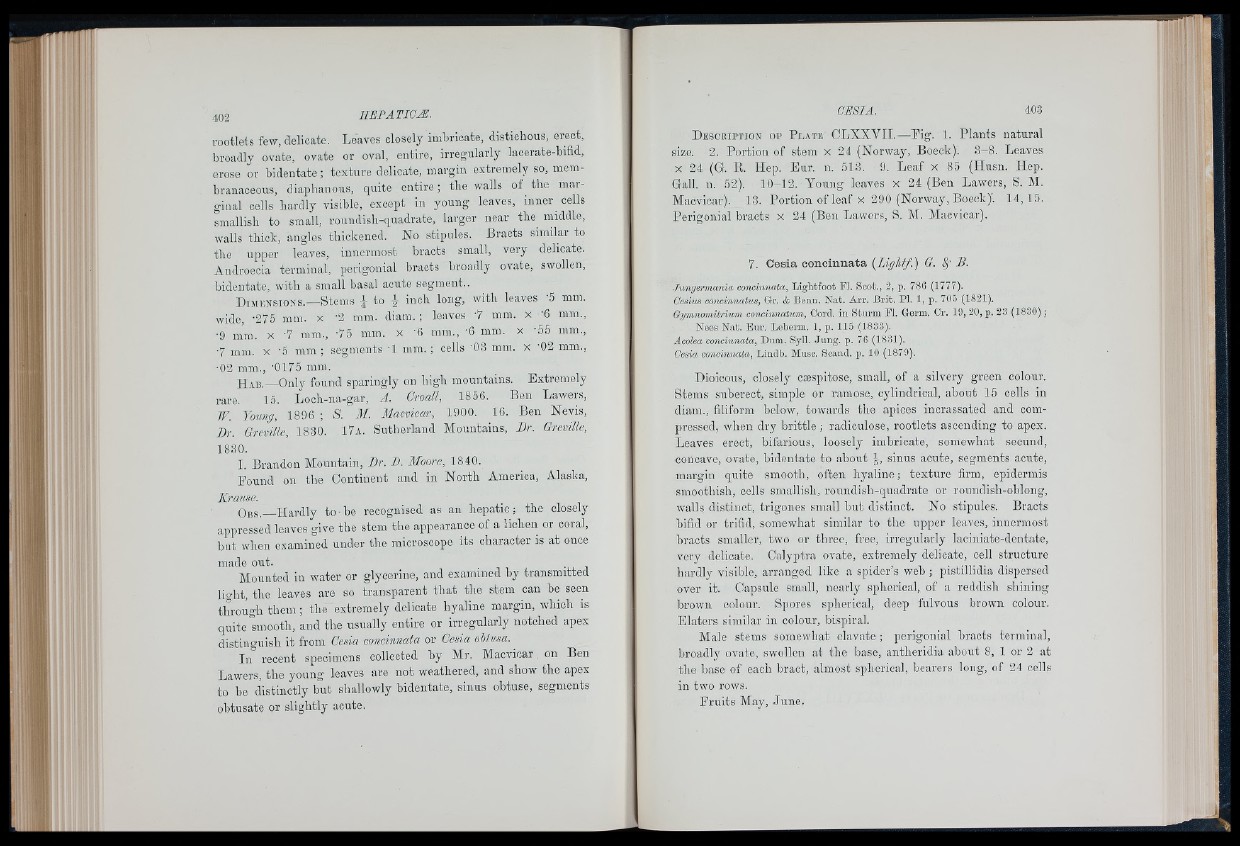
rootlets few, delicate. Leaves closely imbrioate, distiobous, erect,
broadly ovate, ovate or oval, entire, irregularly laoerate-bifid,
erose or bidentate; texture delicate, margin extremely so, membranaceous,
diaphanous, quite en tire ; the walls of the marginal
cells hardly visible, except in young leaves, inner ^ cells
smallish to small, roundish-quadrate, larger near the middle,
walls thick, angles thickened. No stipules. Bracts similar to
the upper leaves, innermost bracts small, very delicate.
Androeoia terminal, perigonial bracts broadly ovate, swollen,
bidentate, with a small basal acute segment..
D im k n s i o n s .— Stems to 4 inch long, with leaves A mm.
wide, -275 mm. x '2 mm. diam. ; leaves '7 mm. x '6 mni.,
'9 mm. X '7 mill., ’75 mm. x A iiini., 'G mm. x A5 mm.,
•7 mm. x A 111m ; segments T mm. ; cells '03 mni. x '02 mm.,
•02 mm., -0175 mm.
H a b .— Only found sparingly on high mountains. Extremely
rare. 15. Loch-na-gar, / . Croall, 1856. Ben Lawers,
W. Young, 189 6 ; & " i ¥ . Macvica.r, 1900. 16. Ben Nevis,
Br. Greville, 1830. 17a. Sutherland Mountains, Br. Greville,
1830.
I. Brandon Mountain, Br. D. Moore, 1840.
Found on the Continent and in North America, Alaska,
Krause.
O bs . Hardly to-be recognised as an hepatic; the closely
appressed leaves give the stem the appearance of a lichen or coral,
but when examined under the microscope its character is at once
made out.
Mounted in water or glycerine, and examined by transmitted
liuht, the leaves are so transparent that the stem can be seen
through them ; the extremely delicate hyaline margin, which is
quite smooth, and the usually entire or irregularly notched apex
distinguish it from Cesia concinnata or Cesia ohlusa.
In” recent specimens collected hy Mr. Macvicar on Ben
Lawers, the young leaves are not weathered, and show the apex
to be distinctly but shallowly bidentate, sinus obtuse, segments
obtusate or slightly acnte.
n
D e s c r i p t i o n o p P l a t e CLXXVII.—Eig. 1. Plants natural
size. 2. Portion of stem x 24 (Norway, Boeok). 3-8. Leaves
X 24 (G. It. Hep. Eur. n. 513. 9. Leaf x 85 (Husn. Hep.
Gall. n. 52). 10-12. Young leaves x 24 (Ben Lawers, S. M.
Macvicar). 13. Portion of leaf x 290 (Norway, Boeck)'. 14,15.
Perigonial bracts x 24 (Ben Lawers, S. M. Macvicar).
7. Cesia concinnata (TAghff.) G. fl B.
.Jungermania concinnata, Lightfoot Fl. Scot., 2, p. 780 (1777).
Cesius concinnatus, Gr. & Benn. N a t. Arr. J lrit. PI. 1, p. 705 (1821).
Oymnomitrium concinnaium. Cord, in S turm Fl. Germ. Cr. 19, 20, p. 23 (1830) ;
Nees Nat. Eu r. Leberm. 1, p. 115 (1833).
Acolea concinnata, Dum. Syll. Ju n g . p. 76 (1831),
Cesia concinnata, Lindb. Muse, Scand. p. 10 (1879).
Dioicous, closely cæspitose, small, of a silvery green colour.
Stems suberect, simple or ramose, cylindrical, about 15 cells in
diam., filiform below, towards the apices inorassated and compressed,
when dry brittle ; radiculose, rootlets ascending to apex.
Leaves erect, bifarious, loosely imbricate, somewhat secund,
concave, ovate, bidentate to about J, sinus acute, segments acute,
margin quite smooth, often hyaline; texture firm, epidermis
smoothish, cells smallish, roundish-quadrate or roundish-oblong,
walls distinct, trigones small but distinct. No stipules. Bracts
bifid or trifid, somewhat similar to the npper leaves, innermost
bracts smaller, two or three, free, irregularly laciniate-dentate,
very delicate. Calyptra ovate, extremely delicate, cell structure
hardly visible, arranged like a spider’s web ; pistillidia dispersed
over it. Capsule small, nearly spherical, of a reddish shining
brown colour. Spores sjiherioal, deep fulvous brown colour.
Elaters similar in colour, bispiral.
Male stems somewhat olavate ; perigonial braots terminal,
broadly ovate, swollen at the base, antheridia about 8, 1 or 2 at
the base of each braot, almost spherical, bearers long, of 24 cells
in two rows.
Emits May, June.